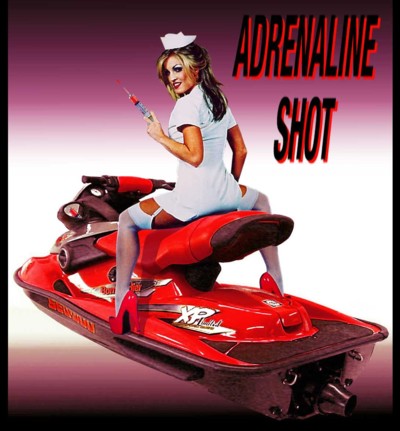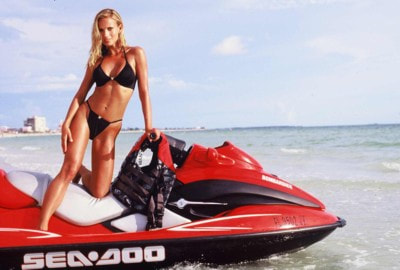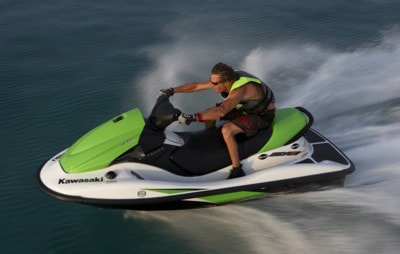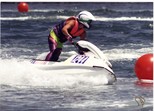|
0 Comments
12/27/2022 0 Comments Can't wait for summerComments To This Article:
Overall Rating For This Article: ••••••••••
The Kawasaki JET SKI® STX®-15F watercraft is the ultimate expression of power, performance and leading-edge technology in the personal watercraft world, and the reason is simple: the brand responsible for building some of the most powerful motorcycles on earth is the same brand that introduced the JET SKI name to the world more than 30 years ago. A high-performance engine from the legendary Kawasaki Ninja® motorcycle line provided the starting point for this dominant JET SKI model. While the bore is the same as that of the smaller JET SKI STX-12F, the stroke is 13.8mm longer, increasing displacement to 1,498cc. This long stroke design delivers a flat torque curve for a smooth spread of power across the entire rpm range. Dual overhead cams, four valves per cylinder, fuel injection and electronic engine control, which harmonizes the fuel and ignition systems, provide maximum performance and reliability. Plus, the fuel injection system utilizes four injectors and a large 60mm throttle body to deliver a quick response. Even with such high-performance attributes, the STX-15F has earned a Three-Star Ultra-Low Emissions rating, meeting the Environmental Protection Agency’s (EPA) strictest standards, as well as the California Air Resources Board (CARB) standards for 2008. The four-stroke engine is rubber-mounted in the hull and includes a water-jacketed, performance-tuned exhaust system, dual mufflers and large-capacity airbox. The STX-15F utilizes a direct drive axial-flow jet pump connected to an oval-edge, stainless steel, three-blade impeller and an 82mm jet pump nozzle for powerful acceleration. Equally important, the STX-15F engine produces its peak power at a relatively low rpm while matching the impeller’s peak efficiency rpm, thus eliminating the need for a complicated gear reduction unit. The result is improved durability, reduced vibration and noise, and improved fuel economy. The STX-15F is also equipped with Kawasaki Smart Steering®(KSS® ). KSS features a steering sensor that is electronically linked to an on-board microprocessor. If the handlebar is fully turned in either direction and the engine rpm drops from a designated rpm, such as when the throttle is released at speed, the microprocessor activates the KSS, which raises engine rpm to provide enough thrust to initiate the desired turn. Assisting with low-speed maneuvering is a reverse bucket that is shaped to deliver optimum thrust for more precise direction control when backing, and the bucket is injection molded to eliminate corrosion. he STX-15F also features Kawasaki’s innovative electronic Smart Learning Operation (SLO). Accessible directly on the instrument panel, SLO can be programmed to place a limit on maximum engine speed so novice riders can experience riding at a reduced speed while they master proper riding techniques. Aggressive turning and high-speed stability are key performance attributes of the STX-15F. Injection-molded sponsons designed specifically for the STX-15F feature a special “lip” for increased cornering grip and high-speed stability. The hull also features a molded-in Kawasaki Splash Deflector (KSD) to help minimize spray on the rider.With its muscular, aggressive look, the STX-15F is lighter and more compact than the competition, yet Kawasaki engineers have created a spacious riding position that makes aggressive performance riding easier and suits a wider range of riders. The stylish hatch cover is constructed from ABS plastic, adding to the fresh, high-quality styling of the STX-15F, and a hydraulic damper holds the hatch cover open, allowing easy access until the rider closes it. The mirrors are also made of ABS plastic and are mounted directly to the deck, adding to the sleek lines The open rear deck of the STX-15F features abundant space for getting into water skis or a wakeboard, and reboarding in deep water is simplified with the automatically retracting boarding step located at the rear of the hull. The rear deck can also accommodate a cooler or other items needed for a day on the water. Other features include a water-resistant storage space, an easily accessible glove box and additional storage space located under the seat.
For extended rides, fuel capacity is a generous 16.4 gallons. Other features include a LCD instrument panel so the rider can monitor the fuel level, speed, engine rpm, trip distance and time. Warning lamps alert the rider to low fuel level or high engine temperature, and a magnetic keyed ignition switch helps deter unauthorized operation. Engine − Adapted for watercraft use from a legendary Ninja sport motorcycle engine − The strong, 1,498cc, four-stroke engine provides incredibly strong low- and mid-range torque − Intake tract designed for maximum performance − Digital fuel injection provides great throttle response, smooth engine performance and quick acceleration, as well as easy starting and excellent fuel economy − Throttle body diameter is 60mm, 6mm larger than the STX-12F − Dual overhead cams (DOHC) are light and compact for less valve train inertial mass − Four-valve cylinder head with large valves provide better intake and exhaust flow to improve torque and power − Intake and exhaust valve lift as well as timing are set to reduce exhaust emissions − Tip-over protection shuts engine off if craft tilts more than 61 degrees − Waterproof ECU and ignition coils protects the ignition system from electrical shorts − Unique semi-dry sump oil system lowers the crankshaft in the engine, eliminates the need for scavenging pumps, and if the craft is capsized the oil stays in the sump instead of flooding the crankcase − Kawasaki’s patented oil separator provides fail-safe venting for the crankcase and prevents oil from flowing into the intake tract if the craft is capsized − Large capacity airbox lowers engine noise and improves air intake flow − Water-jacketed exhaust system reduces noise level and underhood temperatures for better power − Double waterbox mufflers deliver whisper-quiet operation − Has earned a Three-Star Ultra-Low Emissions rating, meeting the Environmental Protection Agency’s strictest standards, as well as the California Air Resources Board standards for 2008 Steering System − Kawasaki Smart Steering (KSS) monitors steering input and engine speed and, when certain conditions are met, raises rpm to initiate a desired turn − Reverse bucket is designed for precise direction control when backing and is made of injection molded material to prevent corrosion − Reverse increases maneuverability in tight places Hull − Hull size is optimized for a sporty, nimble ride − Injection-molded sponsons deliver ultra-responsive turning, while enhancing stability − Three-blade oval-edge stainless steel impeller pitch provides maximum efficiency and incredible durability − Shielded jet propulsion system gives greater protection from damage − Kawasaki Splash Deflector (KSD) helps keep spray off the operator and passenger − Boarding step retracts automatically, making reboarding in deep water easier − Large capacity fuel tank allows more riding between fill-ups Deck − Stylish hatch cover has a muscular, performance look − Handle position makes “stand-up” performance riding easier and provides ample room for a wide range of riders − Spacious, close-to-the-water open rear deck provides plenty of spacious area for putting on skis or a wakeboard and makes deep water boarding easier − LCD multifunction meter system with speedometer, tachometer, hour meter, clock, trip distance, trip time, fuel level and warning lights allow operator to easily monitor necessary information, and also alerts operator to low fuel or high engine temperatures − Smart Learning Operation (SLO) is accessible on the instrument panel, and can be programmed to place a limit on maximum engine speed so novice riders can experience riding at a reduced speed while they master proper riding techniques − Storage compartments in bow, glove box and under seat can carry fire extinguisher, tool kit, cooler and more − Finger-type throttle reduces hand fatigue and increases comfort − Magnetic keyed ignition switch helps deter unauthorized use For more info, go to www.kawasaki.com START EARLEY: “It’s a good idea to get your ski out of storage a little early and start it up. If you’re taking it to a dealer to be summarized or get some repairs, try to do it before the summer, when dealers tend to get overwhelmed.
WARM UP: Coax your PWC out of hibernation. If you stored your Jet Ski with some fuel in the tank and did not use a fuel stabilizer, condition the fuel by adding a conditioner like Pennzoil’s Fuel System Cleaner and Stabilizer. However, if you experience a no start and the fuel seems stale, then take your pwc to a qualified technician where trained technicians are equipped to drain and dispose of fuel. MAINTAIN LUBRICATIONS: If you own a 4 Stroke engine, and didn’t do it last fall, now’s a good time to change the engine oil and filter, and drain and replace pump oil. You will also want to add grease to all grease fittings to keep bearings and seals lubed. For those of you who own 2 strokes, top off the oil reserve with fresh two-cycle oil, then drain and replace pump oil. You would want to grease fittings too. SECURE LOOSE ENDS: Check for loose wires. Check throttle and trim cables to make sure they work properly. CHARGE YOUR BATTERY: Charge and reinstall the battery. These tip will help you get a good start to summer fun. By Bobby Boop 12/27/2022 0 Comments Know The Watercraft Rules On The WaterKnow The Rules.
Personal watercraft (PWCs) are targets for new laws and restrictions. The best way to change the PWC “bad-boy” image is to respect other boaters around you by following the laws. Start by knowing the “Rules of the Road,” a code that every boater is legally required to follow. Not only are there safety requirements, but the rules also extend into the realm of boating etiquette. They tell you how to signal and pass other vessels, which boat has the right of way, and how to read aids to navigation. Chances are your state has its own set of PWC rules. For instance, Rhode Island requires state residents to have a PWC license in order to promote safe, courteous riding. There are also local rules concerning PWC operation. Know Your Machine. Depending on how much noise and smoke they emit, some watercraft are considered “ruder” than others — old carbureted 2-strokes are considered the height of rudeness. If you’re one of the majority of riders using a carbureted 2-stroke PWC, the key is to keep your watercraft well-maintained for minimal smoke emission (there’s probably not much you can do about noise). Manufacturers have been addressing both smoke and noise pollution with a new breed of low-decibel 4-strokes. The good news is that within a few years, carbureted technology will be a thing of the past, so many of the big complaints against PWCs will go up in smoke. Know Yourself. You also need to develop your own riding skills to promote safety and courtesy. They include learning to use the throttle and steering properly (many beginners let go of the throttle when they’re heading at another boat or obstacle, thus losing steerage), practicing high-speed stopping and steering maneuvers, and scanning the horizon constantly for other boats. This includes common-sense maneuvers like slowing down or avoiding anchored boats, not waking or splashing other boaters, and not doing hour-long doughnuts in front of other boats or waterfront homes. The key is to be aware of others while on the water. Accidents can happen in the blink of an eye. Know The Area. Besides being polite to other boaters, there are real and perceived problems associated with PWC and habitat destruction. In fact, that was one of the main arguments for PWC bans in national parks last summer. A little awareness for environmental concerns can go a long way. So, stay clear of nesting grounds and fragile ecosystems. Also, keep your eyes posted for swimmers. Areas around coves and docks can fill up quickly with people who might want to take a dip, so before you decide to gun it, scan the area for potential problems. As far as the wakes go, just apply the golden rule of PWCs — splash unto others as you would like them to splash unto you. By Bobby Boop When the weather outside gets chilly, it's important to take proper care of your watercraft to make sure it is in shape for when the water gets warmer and it's time to ride the waves again.
Winterizing your PWC will help protect it against the off-season elements during storage and get you on the water sooner when the riding season starts. If you don't take your Jet Ski, Sea Doo or Waverunner into a professional shop for winterization, here are a few tips on how you can do it yourself and save a little money in the process. (Be sure to read your owner's manual and all product instructions for proper safety and maintenance information.) Drain the engine Get ready to store your personal watercraft for the off-season months right after you take your final ride of the season. The first thing you'll want to do when you take your PWC out of the water is drain the water from the engine. The best place to do this is right at the loading dock when the craft is out of the water and the trailer is tilted so the stern is lower than the bow. Start the engine a few times letting it run for no more than 30 seconds to prevent the engine from overheating. While the engine is running, turn the handle back and forth. This drains any excess water out of the engine. Clean It Up Take extra care to thoroughly clean your PWC one last time. Wash down the exterior of the craft using the same kind of soap that you would use to wash your car. It might take some extra elbow grease to remove all the build-up, but removing the algae and grime now will be much easier than trying to clean it off after the storing period. When you're finished cleaning make sure there is no water in the hull, and the interior and exterior of the watercraft are completely dry. For extra protection on the exterior, finish your wash with a wax job and use a light coat of multi-purpose lube to coat any metal surfaces such as latches and hooks. Gas It Up Fill up the gas tank to prevent condensation over the storing period. Top off the fuel tank with the appropriate amount of gas stabilizer, according to the instructions on the container. Using stabilizer prevents the gas from getting gummy, which can eventually clog the carburetors and make for a messy problem. Start up the engine a few times for no more than 30 seconds. This not only allows the stabilizer to work its way through the engine and the carburetors but will drain any excess water out of the engine as well. Remember to be cautious of where you store the PWC with a full gas tank since gas is extremely flammable. Storage near any heat source or source of sparks is very dangerous. Oil It The next step is to spray fogging oil through the carburetors and spark plug cylinders. Begin by removing the air cleaners. This will allow you to spray the oil directly into the carburetor throat. Start the engine and spray the fogging oil into the throat of both carburetors while it is idling. Continue spraying until the engine stalls and then replace the air cleaners. Next remove the spark plugs, making sure the wires are grounded, and spray fogging oil into each hole for a couple seconds. Place a rag over the holes and push the start button of the craft. This will not start the engine but will allow the oil to coat and disperse internally. Clean any oil that may have dripped and then reinstall the spark plugs. Remove the battery Check your battery and battery chargers for specific safety instructions. Remove the battery by first disconnecting the negative terminal followed by the positive terminal. Store the battery indoors in a warm place such as a shed or garage. We do not recommend storing the battery in your house, as it can give off dangerous fumes. If the battery case is older, place the battery on a rubber mat for storage. Placing an older battery on concrete may cause the battery to conduct a current and eventually discharge it. Attach the battery to a trickle charger and remember to check the battery water level every month throughout the storage period. Storage Because your craft will have a full tank of gas, remember to be cautious about the location that it will rest. Put your trailer in a level position in the place where you intend to store the craft. The best way to prevent flat or corrupted trailer tires over the storing season is to take the tires off, store them indoors and use concrete blocks or a jack to hold the trailer in position. If you choose to leave the tires on, cover them with tarps or durable plastic bags. To prevent rotting, place boards under the tires if the ground is gravel or dirt. Once the trailer is in place, unlatch the seat of the PWC to allow air to circulate through and prevent any moisture from being trapped inside. Place steel wool or a rag inside the exhaust to prevent any animals or bugs from nesting there. Finally, place your cover over your PWC to keep it clean and protected while it's being stored. If you follow these simple winterizing instruction you will have a longer lasting life of your Jet Ski, Sea Doo or Waverunner. By Bobby Boop 12/27/2022 0 Comments Jet Ski Ride Area Japankinawa, Japan
Report: Miyako Island, Okinawa, Japan.Paradise island for PWC. From north latitude 24 degrees to 25 degrees, and the 125 east longitudes to 126 degrees. From metropolitan Tokyo in Japan, it takes 2.5 hours by air. The beautiful cobalt blue sea and fresh coral reef. Those who want to enjoy PWC with this background need to access below. Jet Stream - http://kura.zone.ne.jp/ Thanks Kura Scott is with the US Air Force and happens to be stuck on the Sub Tropical Island of Okinawa. Part of Japan, not to far from the Philippines and Guam. He says Sub Tropical because it does get chilly here 55 degrees. Go buy a shorty and you can ski year round. Nice beaches all the way around the island really warm water in the summer, and some nice waves too! And just think YOU GUYS PAY SCOTT TO BE HERE DOING THIS! 12/27/2022 0 Comments Jet Ski Ride Area MexicoCancun is Mexico's premiere turist destination and is located in Mexico's State of Quintana Roo in the Yucatán Peninsula (about 2 hrs flight from Miami or Atlanta) and has the most beautiful white sand and turquoise-colored clear waters of the Caribbean. The place is a 21-mile long 7-shaped island surrounded by the sea and the Nichupté lagoon, where you can ride to your hearts content. There are lots of flights from major US cities directly to Cancun and accomodations range from 1 star econo-hotels or bed and breakfast inns for students to 5 star, diamond award, mega-resorts. The water conditions is great almost everyday year-round, ranging from the mirror-like tranquility of the lagoon to 6-12 ft waves on the open sea side of the place. There are very little regulations and there is no fee to use the public beaches and the waterways. Except from a few minor "ecological-reserve" areas, you can ride anywere and, in my opinion, this place shure is one of the best places to ride anywhere in the world.
Joe Ramos-Zurita 12/27/2022 0 Comments Jet Ski Ride Area HollandHolland Report: Here is one for all Euro-skiers or all of you flying over: What do you need? - Same as in most of northern Europe you will need a boating license for motor equipped vessels. One for rivers and lakes, and another for coastal waters. Fire extinguisher, paddle (sit-downs), and life jacket are mandatory and you have to have at least one part of the book: "Bootalmanach", a sort of map and regulations register. Also you have to register your PWC, which is easily and permanently done in any post office for the cost of Hfl. 57.50 (about 25$). When on the water, try to carry the boating license and the registration papers, and make sure to have the registered number on the hull. Cops can be a bitch! Where may you go? - In general Jetskies may be used in any area where no speed limits apply, unless they are prohibited by local regulations. This sounds better than it is, because almost all lakes are restricted this way. Holland has a lot of coast, all beach, and the North Sea is free ride area. A good wetsuit however is recommended and during day it is always choppy. Stupidly it is forbidden to access the water by crossing the beach, and to get anywhere close to the shore. This is meant to avoid accidents with swimmers, but also means that wavejumping cannot be done legally and you always have to find a port to ski out of; and even this sounds easier than it is, since most ports are commercial and do not have public ramps. The large rivers are a good alternative, and you do not have to worry about salt in the engine. Be careful though not to run into partly submerged cables and rock "wake-breakers" close to the shores. This forces you to ride more in the middle of the river where in Europe there is a good deal of commercial traffic going on. Tugboats produce a good wake to jump, but are also extremely dangerous! If you fall, there is no way, those barges can avoid you or even see where you are. Also in strong current rivers, being separated from your ski can mean you just lost it. Side arms of rivers are mainly calm, no commercial traffic and some are free to speed. Holland also has an internal sea called "Ijsselmeer". It is brackish water, and not as cold as the North Sea. It also ought to be 100% free ride area and due to a lot of marinas, access should be no problem. Another very good area to ride is in the south west of Holland, in the province of "Zeeland". Since the Dutch sealed off these scattered river outlets with dikes in their fight against constant flooding, the waters behind the dikes became excellent riding places: Brackish if not sweet water, no commercial traffic, warm water temperatures and wide open surfaces. To avoid accidents and in order to separate groups of different interest, the areas behind each dike are reserved for different sports: Brielse Maas, Haringvliet, Oosterschelde and Westerschelde are open to waterskiing and PWC; Grevelingermeer and others are absolute restricted to sailing, diving and very slow motoring. My personal favorite is the "Haringvliet" in Zeeland as it is the closest when coming from The Hague or Rotterdam. There is a public ramp where parking or even overnight camping is absolutely free of charge. That spot is on the map above to the left of Hellevoetsluis, in the corner just above the 41.
Get wet, but ride safe to grant us all the further access to these great riding areas. Thanks Dutch Dude |
Magazine For Jet Ski & PWC NewsContact us for submitting Jet Ski news, Jetski club, manufacture, parts, vintage jet ski or event info. CategoriesAll Accessories A Submit News Bikini Shot Contest Forums Honda Jet Ski Jet Ski Club Jet Ski Racing Jet Ski Ride Area International Jet Ski Ride Areas East Of Mississippi Jet Ski Ride Areas West Of Mississippi Jet Ski Video Mechanic Tips Parts Diagram Polaris School Sea Doo Yamaha Parts Yamaha Waverunners Archives
February 2024
|
Company |
Stores |
A division of Inland Jet Sports Group
|
|
Site Design By Aggressive Pro
|
2024 © JETSKIPARTS.BIZ
|






 RSS Feed
RSS Feed



